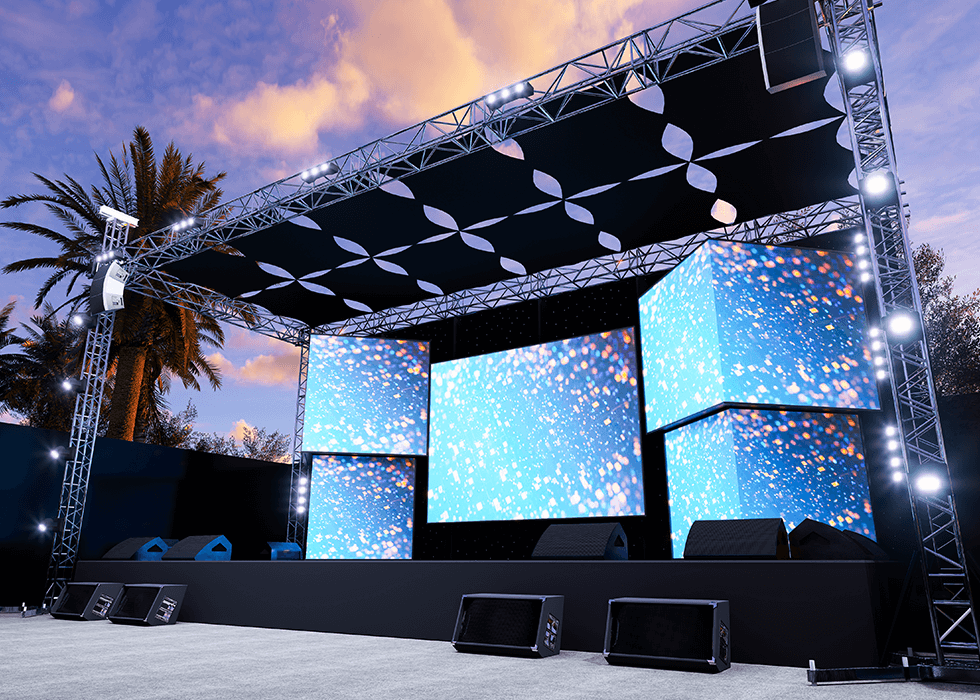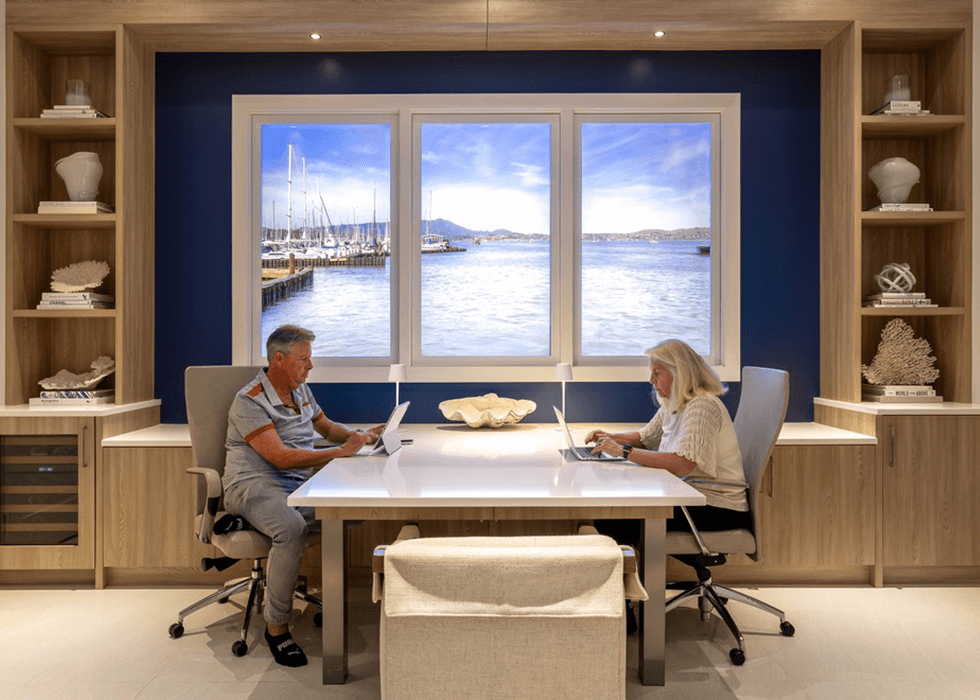
Hybrid Event Production: A Comprehensive Guide for AV/IT Professionals
Hybrid events are transforming how organizations create experiences that connect, inform, and inspire. By blending the energy of in-person interaction with the reach of virtual platforms, hybrid events boost attendance, amplify ROI, and extend impact, particularly when supported by a smart event strategy, the right technology, and flawless execution. This guide outlines the key elements for delivering effective and impactful hybrid events.
Understanding Hybrid Event Production
While the COVID-19 pandemic accelerated the shift toward hybrid events, organizations have embraced the converged format as a way to engage in-person and virtual audiences. Hybrid events have become essential for creating cohesive experiences that resonate across global conferences, regional trade shows, and internal meetings, delivering strong engagement and measurable results. They offer both hosts and attendees numerous benefits, including:
- A Wider Reach for Organizations: Virtual components open the door to global participation, allowing organizations to extend their event beyond local or regional boundaries. Executives, clients, and partners across time zones can easily join, eliminating costly travel and increasing brand visibility.
- Greater Cost Efficiency for Event Hosts: With fewer in-person attendees, expenses related to travel, lodging, and venue capacity are significantly reduced. These savings can be redirected toward better content, premium speakers, and digital enhancements that elevate the overall experience.
- Actionable Data Insights for Organizers: Digital platforms provide real-time analytics, enabling hosts to track engagement, measure content performance, and assess audience sentiment. These insights provide a valuable feedback loop to refine strategy and improve future events.
- Increased Flexibility for Attendees: Hybrid events give participants the freedom to attend in person or virtually, making events more accessible. Whether due to time constraints, travel barriers, or personal preferences, attendees can engage in the way that works best for them.
The Role of AV/IT Professionals in Hybrid Events
AV/IT professionals work to ensure that the technology behind both the in-person and virtual components works flawlessly. They manage the integration of various technical elements, including streaming platforms, audio/video systems, and interactive tools, to ensure a smooth, engaging experience for all stakeholders. Working behind the scenes, they contribute to a flawless hybrid experience in the following ways:
- Technological Integration: They oversee the integration of key technologies, from lighting and sound to live streaming, ensuring all elements work together harmoniously to create a cohesive, unified experience for all attendees.
- Real-Time Monitoring for Continuous Flow: Throughout the event, they continuously monitor the video quality, audio clarity, connectivity, and device performance. Their vigilance allows them to address technical issues before they disrupt the experience.
- On-the-Spot Technical Support: They stand ready to swiftly tackle any technical challenge that arises, from login issues to streaming delays and audio disruptions, to increase attendee satisfaction and ensure the event flows smoothly.
These skilled professionals work tirelessly behind the scenes to ensure everything runs smoothly, helping the event host create the engaging experience that attendees have come to expect.

3 Key Components of Successful Hybrid Events
Delivering a successful hybrid event starts with seamlessly integrating technology, encouraging real-time audience interaction, and effectively managing content across various platforms. To make it all work, it’s essential to focus on a few key strategies:
1. Technological Infrastructure: Creating the Cornerstone for Success
Even the most compelling content can fall short if technical issues or platform limitations disrupt the momentum. To prevent these challenges, it’s essential to choose the right tools, platform, and support systems.
- AV Equipment: Invest in high-quality cameras, microphones, and switchers to deliver crisp audio and video streams. Clear visuals and sound are critical for keeping virtual participants engaged and establishing credibility for your event.
- Internet Connectivity: Ensure a dedicated, high-speed internet connection with ample bandwidth to handle simultaneous uploads and downloads. Opt for wired connections whenever possible to minimize latency and avoid disruptions.
- Streaming Platforms: Select platforms like Zoom, Microsoft Teams, or tailored solutions that deliver stable streaming with features like chat, Q&A, breakout rooms, real-time analytics, user-friendliness, and reliability.
With the right tools in place, the stage is set for a seamless, engaging experience that keeps both in-person and virtual attendees connected and satisfied.
2. Audience Engagement: Fostering Participation
Hosting a truly memorable event involves creating opportunities for authentic interaction, whether attendees are seated in a front-row seat at a convention hall or in a pair of sweats at their dining room table. These key elements help capture attention and foster meaningful engagement across both physical and virtual spaces:
- Interactive Content: Incorporating multimedia elements, like dynamic slides, video segments, live demos, or product walkthroughs keeps presentations lively. Use real-time tools, such as polls or quizzes to drive attention and dialogue.
- Q&A Platforms: Enabling attendees to submit questions in real-time via a dedicated interface keeps them engaged and tuned in to hear presenters' responses, while moderators can prioritize questions and facilitate balanced discussions between physical and virtual participants.
- Polling and Surveys: Using mid-session polls to gather instant feedback or measure opinions enables audience measures and analytics. The use of post-session surveys also offers insights into the attendee experience, helping to improve future events and demonstrating that organizers value attendee input.
By offering interactive content and real-time communication, hosts can ensure that every attendee, whether in-person or virtual, feels actively involved and primed to attend future events.
3. Content Management: Delivering A Consistent Experience
Content consistency is key for hybrid events. Attendees expect the same high-value experience whether they’re sitting in the front row or tuning in from their laptop. Achieving this requires careful content management and platform design in the following key areas:
- Pre-Event Preparation: Test all media formats, transitions, and links beforehand. Ensure embedded videos work across devices and that backup content is available in case of tech failure.
- Content Adaptation: Tailor slide designs and speaker scripts with both in-person and online viewers in mind. Avoid in-room references that alienate virtual attendees, and make sure visuals are readable on smaller screens.
- Post-Event Access: Provide recorded content through an online portal. Offering on-demand access not only adds value for attendees but also creates a long-tail opportunity for continued engagement or lead generation.
Consistency in content delivery is essential for hybrid events. By managing content effectively and adapting it for both in-person and virtual attendees, you ensure a smooth, engaging experience that extends beyond the event itself.
Steps to Planning a Hybrid Meeting
Planning and executing a hybrid meeting is a complex undertaking that involves more than simply sending invites and connecting technology. Successful hybrid meetings require meticulous preparation, seamless coordination, and attention to detail to ensure a smooth experience for both in-person and virtual participants. These five essential steps help ensure everything runs smoothly from start to finish.
1. Pre-Event Preparation: Establish a Strong Foundation
Proper preparation lays the foundation for a successful hybrid event, ensuring that everything runs smoothly on the day.
- Technology Checks: Conduct full equipment run-throughs, including camera feeds, microphone quality, software compatibility, and redundancy systems. Check firewall settings and device permissions to avoid last-minute roadblocks.
- Platform Training: Ensure all moderators, hosts, and technical staff understand the chosen virtual platform’s features, from screen sharing to breakout rooms. Assign support roles and document escalation procedures for quick troubleshooting.
- Rehearsals: Run complete simulations with presenters and AV staff. Test transitions between live speakers and virtual content, ensure cue timing is understood, and stress-test the system under load conditions.
2. During the Event: Manage Issues in Real Time
Managing a hybrid event requires adaptability to ensure everything runs smoothly. Real-time event management should focus on these key elements:
- Real-Time Monitoring: AV/IT teams should monitor internet speed, video resolution, mic levels, and stream quality live. Watching the audience chat for complaints is another quick way to spot unnoticed issues.
- Troubleshooting: Develop a tiered support system to escalate and resolve issues quickly. Maintain open channels for presenters to alert the technical team discreetly during the event.
- Engagement Management: Assign moderators to handle audience questions and comments, encourage chat participation, and push out reminders about key moments. Keep both live and remote audiences energized and engaged.
3. Post-Event Management: Gather Insights
After the event wraps up, it’s essential to assess its overall success and gather insights for future enhancements. To effectively evaluate and improve, consider these critical steps:
- Data Collection: Analyze participation rates, engagement metrics, technical performance, and platform analytics. Track user behavior such as video drop-offs and session attendance to identify content strengths and weaknesses.
- Follow-Up: Send thank-you emails, event highlights, and feedback surveys within 24-48 hours. Personalized communication strengthens brand relationships and encourages re-engagement.
- Recording Access: Post sessions online with captions and timestamps. This provides value for those who missed the event and extends the life of your content as a marketing or training asset.
4. Technical Challenges: Overcome Hiccups
Technical issues, such as connectivity problems or AV glitches, can severely disrupt the flow of a hybrid event. To prevent these risks, proactive planning is essential:
- Pre-Event Testing: Perform end-to-end tests with all equipment and platforms in the environment where they’ll be used. Validate compatibility between camera feeds, laptops, streaming software, and output systems.
- Back-Up Solutions: Set up backup internet hotspots, redundant AV equipment, and a secondary streaming link. Have replacement mics, cables, and batteries within reach to quickly swap out faulty hardware.
- On-Demand Tech Support: Staff a helpdesk accessible by phone, chat, or email. Offer support hours before and during the event to help attendees log in, navigate the platform, or resolve basic tech issues.
5. Audience Engagement: Sidestep Barriers
Creating an engaging experience for both in-person and virtual attendees requires thoughtful planning and execution. To achieve balance and inclusivity:
- Equal Engagement Opportunities: Ensure hybrid-friendly tools allow virtual attendees to contribute just as actively as those in the room. Integrate Q&A, polling, and chat across both platforms, not just in the physical space.
- Hybrid Networking Opportunities: Offer digital breakout sessions, one-on-one virtual meetups, or AI-powered matchmaking tools. This ensures that remote attendees can form meaningful professional connections.
- Inclusive Content Delivery: Make sessions accessible with live captions, sign language interpreters, and translation options. This not only meets compliance requirements but also broadens the audience's inclusivity.
Future Trends in Hybrid Events
The future of hybrid events will be driven by advanced technologies that are raising the bar for interactivity, scalability, and personalization. This evolution brings new opportunities and new expectations that go beyond streaming video and setting up mics, calling for immersive environments, intelligent automation, and a bulletproof tech stack and infrastructure that includes these technologies:
- Artificial Intelligence (AI): AI can automate post-session transcription, live captioning, and multi-language translation. On the engagement side, AI-driven analytics and recommendation engines help shape content delivery based on participant behavior.
- 5G Connectivity: The rollout of 5G is a game-changer for bandwidth-hungry hybrid setups, dramatically improving streaming quality, reducing latency, and ensuring stable connections for remote users, even in dense environments.
- Augmented Reality (AR) and Virtual Reality (VR): AR and VR provide immersive experiences that enable remote attendees to interact with content by creating virtual exhibition booths and providing VR-enabled classrooms or training simulations.
- Interactive Streaming Platforms: These platforms feature breakout rooms, live chat, audience polling, and real-time Q&A to keep attendees engaged, bridging the gap between in-person and virtual audiences to create an interactive experience for all.
- Event Analytics & Reporting Tools: By gathering data from both physical and digital attendees, these tools offer valuable insights into attendee behavior, helping event planners adjust on the fly and improve future event strategies.
- Cloud-Based Collaboration Tools: Cloud-based document sharing, presentation hosting, and team collaboration platforms ensure all stakeholders have access to event resources, regardless of their physical location.
These AV trends are reshaping the AV/IT approach to hybrid events. As expectations rise, so does the need for teams that can architect streamlined, technology-based environments capable of adapting in real time. Mastering these tools enables AV/IT professionals to design experiences that are as smart and scalable as they are immersive.
Hybrid Event Production: The Takeaway
Success in hybrid event delivery relies on seamless coordination, cutting-edge technology, and the expertise of AV/IT professionals to create interactive, data-driven experiences that foster real-time connections and valuable insights. To stay ahead, organizations must anticipate emerging trends, such as the use of AI, AR/VR, and 5G, among others. AV/IT professionals who embrace innovation will lead the charge in shaping how audiences connect, learn, and engage in the years to come.
Image credit: Getty/Anchiy









